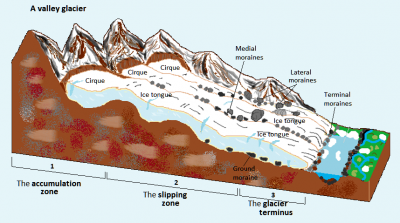
Cirques
Cirques are deep hollows near the top of a glacier, formed where a glacier has moved over an area and worn away the rock. The glacial cirque is opened on the downhill side while the cupped section is steep. The cliffs on the sides slope down and combine and converge from three or more higher sides. The floor of the cirque is bowl-shaped because of the convergence zones of combining ice flows from a different direction and the debris accompanying them. A Cirque experiences greater erosion because of the accompanying rock burdens which may also over deepen the level of a cirque. Cirques subjected to seasonal melting often form small lakes called tarns behind the Moraine.
Accumulation zones
Accumulation Zones are found at the top of glaciers, where the snowfall has built up, often over hundreds of years. Glaciologists subdivide glaciers into glacier accumulation zones, based on the melting and refreezing occurring. These zones include the dry snow zone, in which the ice entirely retains subfreezing temperatures and no melting occurs. Dry snow zones only occur within the interior regions of the Greenland and Antarctica ice sheets. Below the dry snow zone is the percolation zone, where some melt water penetrates down into the glacier where it refreezes. In the wet snow zone, all the seasonal snow melts. The melt water either percolates into the depths of the glacier or flows down-glacier where it might refreeze as superimposed ice. A glacier’s equilibrium line is located at the lower limit of the wet snow zone.
Valley glaciers
Valley glaciers flow through steep-walled valleys. They eventually wear down the valley sides, making them much rounder. Valley glaciers that flow far enough to reach the sea are called tidewater glaciers. Such glaciers are often the source of numerous small icebergs that might pose a problem to navigating vehicles. Often fjords are formed at the edges of such glaciers when the glaciers retreat and sea water fills the void. A hanging glacier is a part of a valley glacier system. Such glaciers originate high on a glacial valley’s walls and descend to a certain extent along the valley before making an abrupt stop, usually at a cliff. Such glaciers are called hanging glaciers and ice fall and avalanches originating at such glaciers are responsible for snow and ice on the valley floor lying below. When such hanging glaciers retreat, hanging valleys are formed. The Mer de Glace glacier on the Mont Blanc massif’s northern slopes is a valley glacier in the French Alps.
Lateral moraines
Lateral moraines are long ridges of rock, soil, and dirt left along the sides of a moving glacier. They form only in the ablation zone of a glacier (where more ice is melting than is accumulating as snow each year). This makes them good indicators of where the line between the accumulation zone and the ablation zone—the equilibrium line—occurred on past glaciers. They often remain on the landscape long after glacier retreat and are frequently contiguous with terminal moraines.
Medical moraines
A medial moraine is found on top of and inside an existing glacier. Medial moraines are formed when two glaciers meet. Two lateral moraines from the different glaciers are pushed together. This material forms one line of rocks and dirt in the middle of the new, bigger glacier.
If a glacier melts, the medial moraine it leaves behind will be a long ridge of earth in the middle of a valley.
